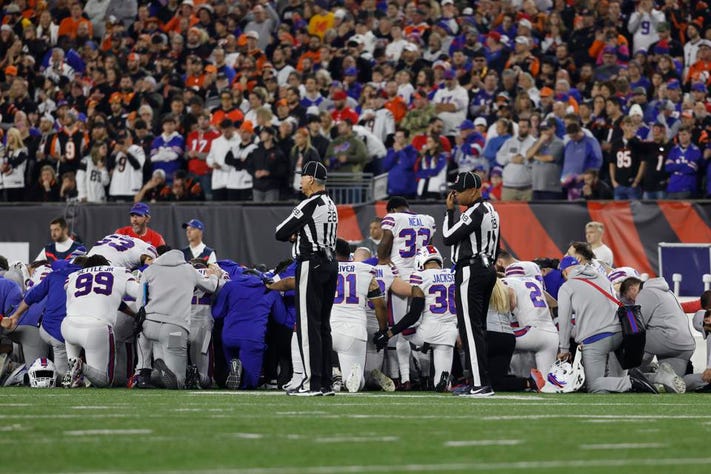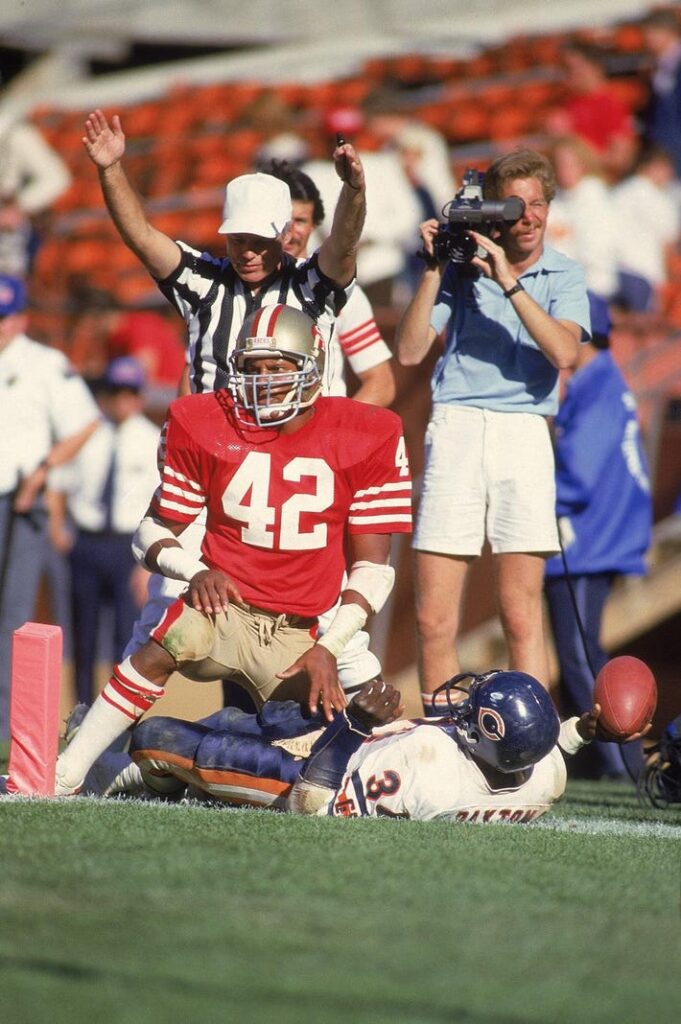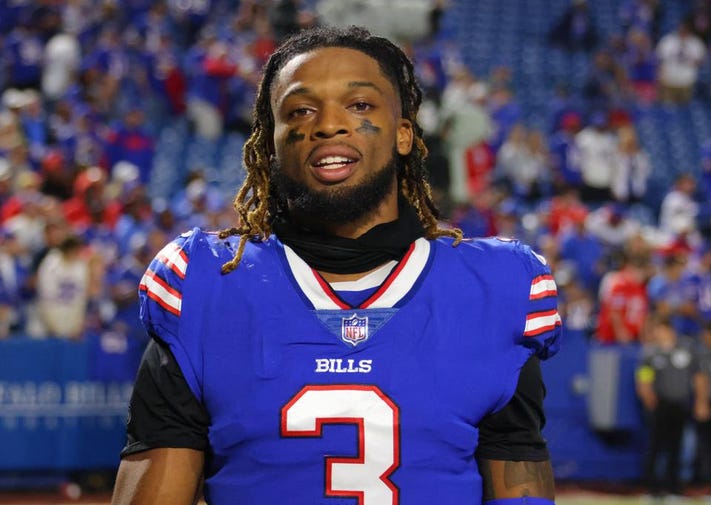Damar Hamlin’s Life-Threatening Injury Is Wake-Up Call For NFL
Written by: Leonard Armato for Forbes.com
When Damar Hamlin collapsed and was administered CPR on the field during the NFL game between the Buffalo Bills and the Cincinnati Bengals it seemed as if the world stood still—on the field, in the broadcast booth, among those watching on TV, and soon those connected via social media. Hamlin’s heart had stopped and had to be resuscitated via CPR combined with the use of a defibrillator.

players huddle after teammate Damar Hamlin #3 collapsed following a tackle against the Cincinnati Bengals during the first quarter at Paycor Stadium on January 02, 2023 in Cincinnati, Ohio. (Photo by Kirk Irwin/Getty Images)
GETTY IMAGES
When I spoke with Dr. Mariell Jessup, Chief Science and Medical Officer of the American Heart AssociationAHA (AHA) about the incident, she said, “treatment like this within moments of collapse is absolutely essential in saving someone’s life.” Fortunately, the Bills staff was prepared to administer treatment on the spot and most recently the team issued a statement that Hamlin has made “remarkable improvement” towards recovery.
People often search for purpose in their life, wondering, what they were put on earth to do and what type of mark they will make to improve the lives of others. Hamlin, who showed his commitment to giving back, may also have a lasting effect on the culture of the NFL as his case can change the way the NFL treats its players as compared with others sports.
Historically, NFL players were viewed by the public and thought of as gladiators, willing to sacrifice their bodies at all costs for the good of the team and the fans. All this despite death, paralysis and even dismemberment.
During the period of the San Francisco 49ers dynasty in the 1980s, I was the agent for NFL Hall of Famer and perhaps the greatest defensive back of all time, and fiercest hitter in the game, Ronnie Lott. When Lott was playing his goal was to “knock people out” on the opposing team. That’s how you gained respect among your peers. That was the culture of a combatant in battle.
Lott was such a warrior that nothing was more important to him than the game he was playing for his teammates and for the fans. I was with him at the doctor’s office when Lott famously ordered the doctor to cut off the tip of his pinky finger, so he could resume playing the following weekend. While it is part of the folklore that will follow him forever, Lott looks back on that day introspectively. When asked why he chose to amputate his finger rather than miss a game, Lott said it was all about the culture of football.
“I was brought up in a military family who would sacrifice themselves for others and I admired the players before me played injured and with broken bones, people like Larry Wilson and Jack Youngblood,” Lott said at the time. But looking back Lott regrets the decision: “We have become gladiators and we need to bring more compassion to the game.” This “gladiator” culture has produced a number of tragic NFL incidents that have historically been swept aside.

Bears Walter Payton (34) in action, scoring TD vs San Francisco 49ers Ronnie Lott (42), San Francisco, CA 10/13/1985 (Photo by Peter Read Miller/Sports Illustrated via Getty Images) (SetNumber: X32223)
SPORTS ILLUSTRATED VIA GETTY IMAGES
Charles Frederick Hughes who played for the Detroit Lions, suffered a fatal heart attack in the middle of a game with the Chicago Bears in 1971. The game continued.
In 1978, Jack Tatum of the then Oakland Raiders administered a hit on New England Patriots wide receiver Daryl Stingley. The result was that Stingley was paralyzed and spent the remainder of his life in a wheelchair until he died at age 55. The game went on.
In 1991, Detroit Lions guard Mike Utley hit his head on artificial turf in the 4th quarter of a game, paralyzing him from the chest down. He was taken off the field and the game resumed.
In 1997, Detroit Lions linebacker Reggie Brown suffered a severe spinal cord injury after being tackled leaving him motionless on the turf for 17 minutes. After he was administered CPR and carted away, the game recommenced.
In 2001, Pro Bowler Korey Stringer of the Minnesota Vikings collapsed and died from heat exhaustion during a scorching hot day at training camp and nothing stopped.
In 2007, Buffalo Bills tight end Kevin Everett spinal cord was nearly severed by a hit and lay motionless on the field for 15 minutes as medics worked to stabilize him, get him on a stretcher and take him to the hospital. The game continued.
Moreover, there have been numerous instances of players and former players suffering from chronic traumatic encephalopathy (CTE), a neurodegenerative disease associated with repetitive head trauma. According to a study of former college football players, 87% showed the diagnostic signs of CTE and among former National Football League (NFL) players in the sample, that number jumped to 99%.
To their credit, in the case Damar Hamlin, the NFL stopped the game, and whether it will in fact be finished has yet to be determined. Dr. Jessup believes that our culture is becoming more compassionate when witnessing the possibility of death or grave injury and the NFL’s reaction is a reflection of that cultural shift. In recent years, the NFL has also tried to address health issues by instituting a series of rules that addressed spinal cord injuries (no helmet first spearing or hitting a defenseless player or blows to the head) which dramatically decreased spinal injuries and the most vicious of collisions which are primary cause of concussions and CTE. However, it is less than clear the long term effects of the continual impact that is the essence of what football is all about.
This is the elephant in the room because football is the most popular sport in the USA and there are rabid fans and massive amounts of money generated by the sport. So I don’t expect anything drastic to happen soon. But if you ask parent’s these days whether they want their kids to play football, the majority answer with a resounding no.

of the Buffalo Bills after a game against the Tennessee Titans at Highmark Stadium on September 19, 2022 in Orchard Park, New York. (Photo by Timothy T Ludwig/Getty Images)
GETTY IMAGES
However, the Hamlin situation shines a light on something that can be changed immediately, namely the way the NFL treats its players compared to the other major sports leagues. The NFL stands alone as the only major sports league that does not guarantee player contracts despite the fact that football is the most violent and dangerous of all sports, and has the shortest average career length of 3.3 years compared to the NBA 4.8 years and MLB 5.6 years.
Moreover, the NFL requires 3 years plus of service in order to “vest” and qualify for pension benefits and health care post retirement. Since Hamlin is only in his second year of service, he does not qualify for any of this.
As we pray for Hamlin’s full and complete recovery, we have hope that he will be able to look back and say that the suffering he endured improved the compassion and culture in the NFL and secured salary, medical and pension benefits for rank and file NFL players. The time is now for the NFL to step up and proactively grant these important rights to all players and should become a standard part of every NFL contract.
Share this article:
Published on January 5, 2023
Written by Leonard Armato